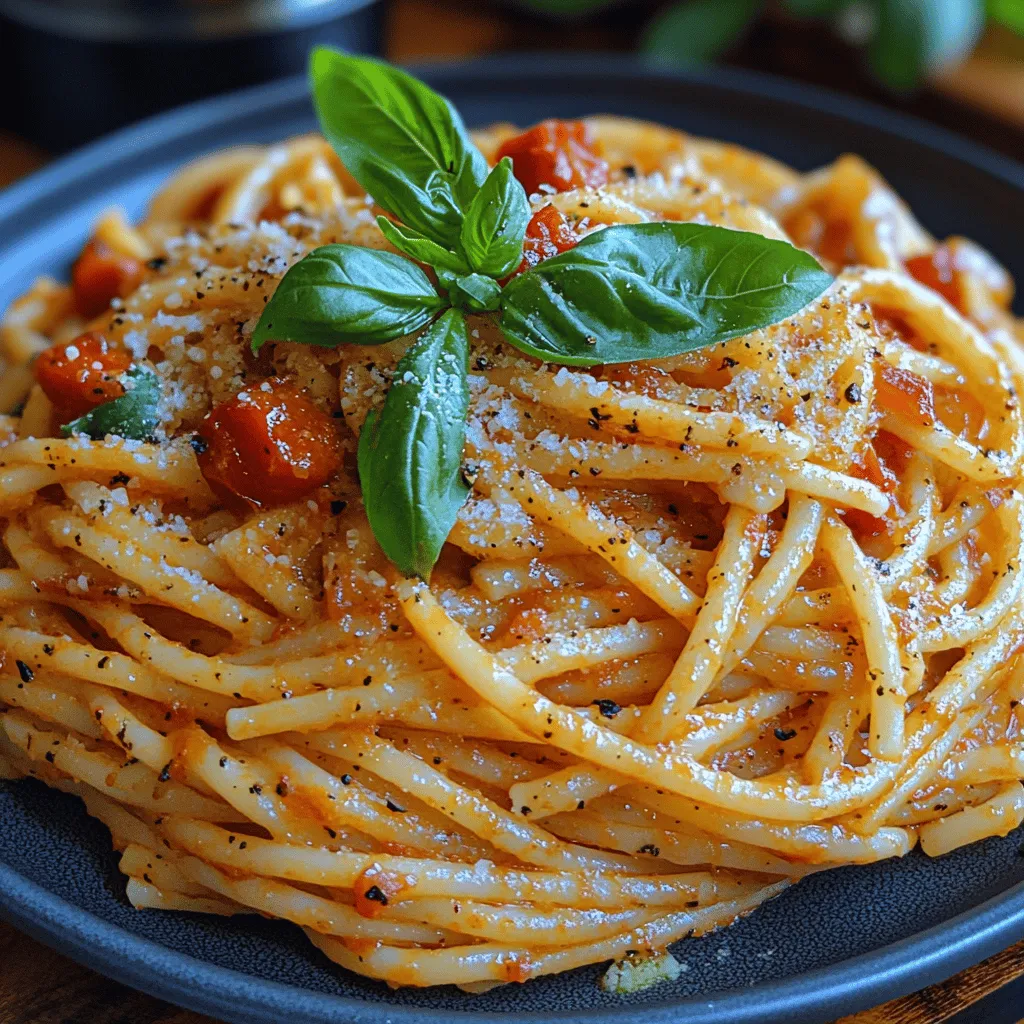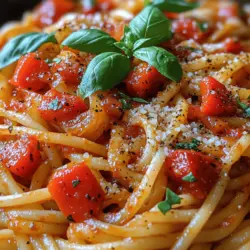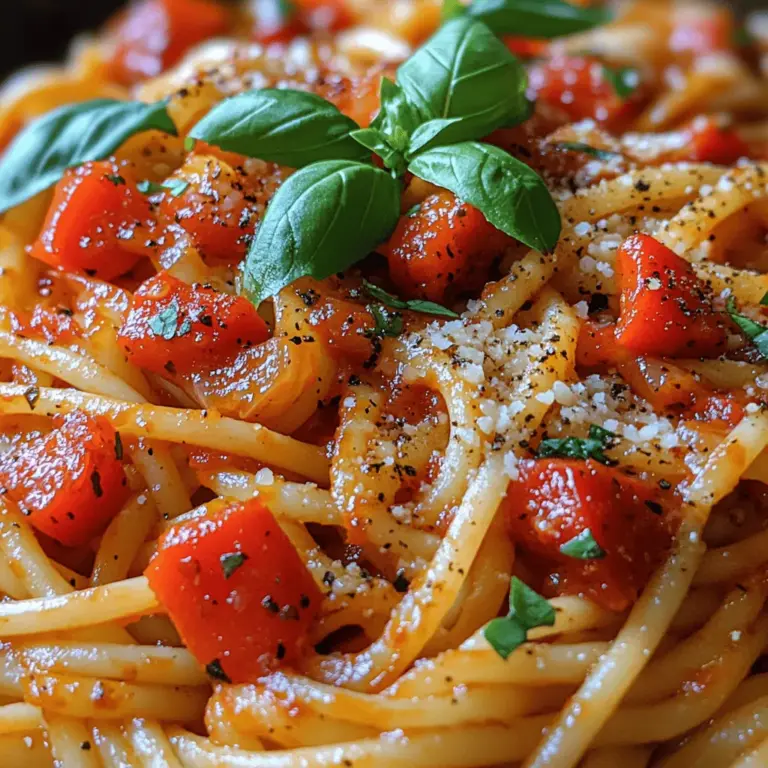Introduction
When it comes to pasta dishes that are both comforting and bursting with flavor, roasted red pepper pasta stands out as a true gem. This dish not only captivates the eyes with its vibrant hues but also tantalizes the taste buds with its rich, creamy texture and a medley of flavors that dance on your palate. Whether you’re hosting a dinner party, preparing a cozy family meal, or simply treating yourself to a delicious weeknight dinner, roasted red pepper pasta is versatile enough to suit any occasion.
What makes this dish even more appealing is its ability to combine simplicity with sophistication. The roasted red peppers lend an inherently sweet and smoky flavor, while the creamy sauce envelops the pasta, making each bite a delightful experience. Plus, this recipe is incredibly adaptable; you can easily customize it by adding proteins like grilled chicken or shrimp, or even tossing in seasonal vegetables to boost its nutritional value.
Understanding Roasted Red Pepper Pasta
Roasted red pepper pasta has its roots in Mediterranean cuisine, where the use of fresh, high-quality ingredients is celebrated. Red bell peppers, a star ingredient in this dish, are known for their vibrant color and sweet flavor. The practice of roasting peppers is not only a culinary technique that enhances their taste but also a tradition in many cultures. Roasting brings out the natural sugars in the peppers, creating a depth of flavor that is simply irresistible.
The health benefits of roasted red pepper pasta are noteworthy as well. Red bell peppers are packed with essential vitamins and antioxidants. They are particularly rich in vitamin C, which supports a healthy immune system, and vitamin A, which is important for vision and skin health. Additionally, the use of olive oil provides healthy monounsaturated fats that can contribute to heart health, while garlic and onions offer anti-inflammatory properties.
One of the greatest advantages of making your own roasted red pepper pasta sauce is that it allows you to control the ingredients and flavors. Store-bought sauces often contain preservatives and added sugars, which can detract from the natural flavors of the ingredients. By crafting your own sauce, you can ensure that each component shines through, creating a dish that is not only delicious but also wholesome.
Key Ingredients and Their Roles
Red Bell Peppers
The primary ingredient in roasted red pepper pasta is, of course, the red bell pepper. These peppers are not only visually appealing but also bring a sweet, slightly smoky flavor when roasted. Nutritionally, they are low in calories and high in vitamins, particularly vitamin C and vitamin A. Their natural sweetness balances well with the savory elements of the dish, making them an ideal base for the sauce.
Olive Oil
Olive oil plays a crucial role in this recipe, serving as both a cooking medium and a flavor enhancer. Rich in healthy fats and antioxidants, olive oil is a staple in Mediterranean cuisine, known for its heart-healthy properties. It also helps to create a silky texture in the sauce, allowing it to coat the pasta beautifully.
Garlic and Onion
These aromatic ingredients are essential for building a flavorful base. Garlic adds a pungent, earthy note, while onions contribute sweetness and depth. Sautéing them together allows their flavors to meld, creating a fragrant foundation for the sauce. The combination of garlic and onion is a classic pairing that enhances the overall complexity of the dish.
Dried Oregano and Red Pepper Flakes
To elevate the flavor profile, dried oregano and red pepper flakes are added. Oregano brings a warm, slightly bitter taste that complements the sweetness of the peppers, while red pepper flakes introduce a hint of heat, balancing the dish perfectly. These spices contribute to the sauce’s depth and complexity, making each bite exciting.
Heavy Cream and Parmesan Cheese
To achieve that signature creaminess, heavy cream is a key ingredient in the sauce. It adds a luxurious texture and richness that makes the pasta feel indulgent. Alongside the cream, freshly grated Parmesan cheese is stirred in, enhancing the sauce with a salty, nutty flavor. Together, they create a velvety coating that clings to the pasta, ensuring a satisfying mouthfeel.
Fresh Basil
Finally, fresh basil is the finishing touch that brings the dish to life. Its bright, aromatic qualities add a burst of freshness, making the flavors pop. Basil pairs beautifully with the roasted red peppers, providing a herbaceous contrast that rounds out the dish. Whether tossed in or used as a garnish, fresh basil is essential for that authentic Mediterranean flair.
Step-by-Step Guide to Making Roasted Red Pepper Pasta
Roasting the Peppers
The first and most crucial step in creating roasted red pepper pasta is roasting the peppers. This process not only enhances their flavor but also transforms their texture, making them easy to blend into a smooth sauce. Here’s how to do it:
1. Preheat the Oven: Begin by preheating your oven to 450°F (232°C). A high temperature is essential for achieving that perfect blistered skin on the peppers.
2. Prepare the Peppers: Rinse the red bell peppers under cold water and dry them thoroughly. Place them on a baking sheet lined with parchment paper, ensuring they are spaced out and not touching. This allows for even roasting.
3. Roast the Peppers: Place the baking sheet in the preheated oven and roast the peppers for about 20-25 minutes, turning them halfway through. You’re looking for the skin to become charred and blistered, which indicates that they are done. This roasting process caramelizes the natural sugars in the peppers and intensifies their flavor.
4. Cool and Peel: Once roasted, remove the peppers from the oven and transfer them to a bowl. Cover the bowl with plastic wrap or a kitchen towel to steam the peppers for about 10-15 minutes. This steaming process makes it much easier to peel off the charred skin. After they have cooled slightly, carefully peel off the skin, remove the stems and seeds, and set the roasted peppers aside.
Importance of Roasting for Flavor Development
Roasting is a transformative cooking method that not only enhances flavor but also adds a delightful complexity to the dish. The high heat caramelizes the sugars in the peppers, resulting in a sweet and smoky flavor that is impossible to replicate with raw peppers. This depth of flavor is what sets roasted red pepper pasta apart from other pasta dishes, making it a standout option for any meal.
Tips for Achieving the Perfect Blistered Skin
To ensure you achieve the ideal blistered skin on your peppers, keep these tips in mind:
– Use Fresh Peppers: Always choose fresh, firm red bell peppers that are free of blemishes. Fresh peppers will roast better and yield a sweeter flavor.
– Don’t Overcrowd the Baking Sheet: Give each pepper enough space on the baking sheet to roast evenly. Overcrowding can lead to steaming instead of roasting.
– Keep the Oven Hot: A high oven temperature is key to achieving that desired char. If your oven runs cool, you may not get the same blistered effect.
Preparing the Sauce Base
With the roasted peppers ready, you can now move on to preparing the sauce base. This step is where the magic happens, as the flavors meld together to create a rich, creamy sauce.
1. Sauté the Aromatics: In a large skillet, heat a couple of tablespoons of olive oil over medium heat. Once the oil is shimmering, add finely chopped onions and sauté until they become translucent and fragrant, about 3-5 minutes. Next, add minced garlic and continue to sauté for an additional minute, being careful not to let it burn.
2. Blend the Roasted Peppers: In a blender or food processor, combine the roasted red peppers with sautéed onions and garlic. Blend until smooth, adding a splash of vegetable or chicken broth to help the mixture blend more easily if necessary. This will be the base of your sauce.
3. Combine and Simmer: Pour the blended mixture back into the skillet and bring it to a gentle simmer. Stir in heavy cream, grated Parmesan cheese, dried oregano, and red pepper flakes. Allow the sauce to simmer for about 5-10 minutes, stirring occasionally, to let the flavors develop and the sauce thicken slightly.
4. Adjust Seasoning: Taste the sauce and adjust the seasoning as needed. A pinch of salt or a squeeze of lemon juice can elevate the flavors even further.
With the sauce prepared, you’re almost ready to bring the dish together. The final steps will involve cooking the pasta and combining everything for a deliciously satisfying meal.
Stay tuned for the next section, where we’ll cover how to cook the pasta to perfection and combine it with the vibrant roasted red pepper sauce for a truly unforgettable dish.

Sautéing Onions and Garlic: Timing and Technique for Optimal Flavor
To start building the flavor base for your Roasted Red Pepper Pasta, the timing and technique of sautéing onions and garlic are crucial. Begin by heating a tablespoon of olive oil in a large skillet over medium heat. Once the oil is shimmering, add finely chopped onions. Sauté them for about 5–7 minutes until they become translucent and start to caramelize, which brings out their natural sweetness.
Next, add minced garlic to the pan. Garlic cooks quickly and can burn easily, so keep a close eye on it. Sauté the garlic for only 30 seconds to 1 minute, stirring constantly to prevent it from browning too much. The goal is to release its aroma without losing its delicate flavor. This combination will create a fragrant foundation for your roasted red pepper sauce.
Blending the Roasted Peppers: Achieving the Right Consistency
Once your onions and garlic are perfectly sautéed, it’s time to incorporate the star ingredient: the roasted red peppers. If you’re using jarred roasted red peppers, simply drain them and add them directly to the skillet. If you’ve roasted the peppers yourself, allow them to cool slightly before peeling off the skins and removing the seeds.
Transfer the sautéed onion and garlic mixture along with the roasted peppers into a blender or food processor. Blend the ingredients until smooth, adjusting the consistency as needed. For a creamier texture, you might add a splash of vegetable broth or a dollop of cream, depending on your preference. The ultimate goal is to create a silky sauce that clings to the pasta beautifully.
Combining Ingredients and Creating the Sauce
With your blended roasted pepper mixture ready, return it to the skillet over low heat. This will allow you to warm it up and meld the flavors together. Now is the time to season your sauce. Start with salt and freshly cracked black pepper, and taste as you go. You can also add a pinch of red pepper flakes for a hint of heat, or a teaspoon of dried Italian herbs like basil or oregano for added flavor depth.
As the sauce simmers gently, consider adding a splash of balsamic vinegar or lemon juice. This acidity will brighten the sauce and balance the sweetness of the roasted peppers, creating a more complex flavor profile. Stir everything together and let it simmer for about 5-10 minutes to allow the flavors to develop fully.
Layering Flavors: How to Effectively Incorporate Spices
When it comes to enhancing the flavor of your pasta sauce, layering spices is essential. Start with the foundational flavors of salt and pepper, then introduce other spices gradually. After the sauce has simmered, you might want to add a tablespoon of smoked paprika for a smoky undertone or some fresh herbs if you have them on hand.
For an extra depth of flavor, consider adding a bay leaf while the sauce simmers; just remember to remove it before serving. Additionally, stirring in a tablespoon of nutritional yeast or grated Parmesan cheese can add a lovely umami richness, making the dish even more satisfying.
Techniques for Achieving the Right Creamy Texture
The creaminess of your roasted red pepper pasta sauce is vital for creating a comforting dish that feels indulgent. If you desire a richer sauce, you can add heavy cream or a non-dairy alternative, such as coconut cream or cashew cream, directly to the sauce. Start with a small amount (about 1/4 cup) and mix it in, tasting to adjust according to your preference.
If you’re looking for a healthier option, consider using Greek yogurt or a blend of pureed white beans for creaminess without excessive fat. Both alternatives will provide a creamy texture and additional protein, making the dish more balanced.
Cooking the Pasta
While your sauce simmers and develops flavor, you can turn your attention to the pasta. Bring a large pot of salted water to a rolling boil. It’s essential to use enough water to allow the pasta to move freely and cook evenly. Add your pasta of choice—whether it’s spaghetti, penne, or fusilli—and cook according to the package instructions until al dente.
Importance of Pasta Cooking Techniques for Best Results
Cooking pasta properly is critical for achieving the best flavor and texture. The salt in the boiling water not only seasons the pasta but also enhances its flavor. Make sure to stir the pasta occasionally to prevent it from sticking together. Taste a piece a minute or two before the package’s suggested cooking time; you want the pasta to be firm to the bite, with a slight chew.
How to Know When Pasta Is Perfectly Al Dente
The term “al dente” translates to “to the tooth,” meaning the pasta should be cooked just enough to retain a slight firmness when bitten. This texture helps the pasta hold up when tossed with the sauce and prevents it from becoming mushy. A good rule of thumb is to check the pasta 2 minutes before the timer goes off. If it’s soft but still has a slight bite, it’s ready to be drained.
Bringing It All Together
Once the pasta is perfectly cooked, reserve about a cup of the cooking water and then drain the rest. This reserved pasta water is a secret weapon; it contains starch that helps bind the sauce to the pasta. Immediately add the drained pasta to the skillet with the roasted red pepper sauce.
Tossing Pasta with Sauce: Tips for Ensuring Even Coating
Using tongs or a large fork, gently toss the pasta in the sauce, ensuring every strand or piece is coated evenly. If the sauce seems too thick, gradually add the reserved pasta water a few tablespoons at a time until you reach your desired consistency. This technique helps create a luxurious sauce that clings beautifully to your pasta.
Adjusting Sauce Consistency with Reserved Pasta Water
The reserved pasta water is your best friend for achieving the perfect sauce consistency. If you find the sauce too thick, adding a little bit of this starchy water will loosen it up without diluting the flavor. On the other hand, if the sauce is too thin, let it simmer for a few extra minutes to thicken up, or add more pasta to absorb some of the liquid.
Serving Suggestions
Presentation is key when serving your Roasted Red Pepper Pasta. To create a visually appealing dish, use a large bowl or platter and twirl the pasta into a nest shape. Drizzle a little extra olive oil over the top and add a sprinkle of freshly ground black pepper. For a burst of color and flavor, garnish with fresh basil leaves or finely chopped parsley.
Suggested Pairings
To complement your roasted red pepper pasta, consider serving it with a simple arugula salad dressed in lemon vinaigrette. This will provide a refreshing contrast to the rich pasta. For wine pairings, a light red like Pinot Noir or a crisp white like Sauvignon Blanc will enhance the meal beautifully.
Creative Garnishing Ideas Using Fresh Herbs and Additional Cheese
Add an extra touch to your dish by garnishing it with freshly grated Parmesan or Pecorino Romano cheese. For an added layer of freshness, sprinkle some chopped fresh herbs like basil, parsley, or chives on top. You can also add a few toasted pine nuts or walnuts for a delightful crunch and nutty flavor.
Nutritional Breakdown
Understanding the nutritional content of your meal can help you appreciate and balance your diet. A typical serving of Roasted Red Pepper Pasta contains approximately:
– Calories: 400–500
– Protein: 15–20 grams
– Carbohydrates: 60–70 grams
– Fats: 10–15 grams
This dish offers a well-rounded balance of macronutrients, primarily carbohydrates from the pasta, healthy fats from olive oil, and some protein from the cheese or yogurt you might add.
Discussion on How This Dish Fits Into a Balanced Diet
Roasted red pepper pasta can be an excellent choice for a balanced meal. The carbohydrates provide energy, while the fiber in the pasta and vegetables aids digestion. By incorporating a variety of colorful vegetables, you’ll also benefit from a range of vitamins and minerals.
Conclusion
Roasted Red Pepper Pasta is a delightful dish that combines vibrant flavors and rich textures, making it a favorite for weeknight dinners or special occasions. With its easy preparation and adaptable ingredients, it’s a recipe that encourages creativity in the kitchen.
By following these detailed steps and tips, you can create a delicious meal that not only satisfies your cravings but also impresses your family and friends. So, don’t hesitate to try making this delightful dish at home. Embrace the joy of cooking and savor the pleasure of sharing delicious meals with your loved ones. Whether it’s a cozy night in or a festive gathering, Roasted Red Pepper Pasta is sure to become a cherished recipe in your culinary repertoire.


